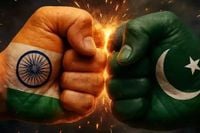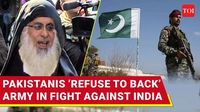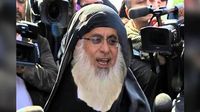In a striking moment that has reverberated across social media, Maulana Abdul Aziz Ghazi, the imam of Islamabad's Lal Masjid, found himself facing a silent audience when he posed a provocative question: "If Pakistan were to go to war with India, how many of you would support Pakistan?" The response was telling—no hands were raised.
This incident, which occurred on May 2, 2025, comes in the wake of heightened tensions following a terrorist attack in Pahalgam, Jammu and Kashmir, that claimed 26 lives on April 22. The stark silence at Lal Masjid, a site historically associated with anti-government sentiment and radical ideologies, reflects a growing disillusionment among Pakistanis, especially in the context of their own government's oppressive policies.
In the viral video, Abdul Aziz Ghazi criticized the governance system in Pakistan, asserting that it has become more oppressive than that of India. He stated, "Today, there is a system of distrust in Pakistan. It is a brutal and dysfunctional system. It is worse than India’s." His remarks underscore a significant shift in sentiment, as he accused the state of systemic violence against its own citizens, particularly in regions like Balochistan and Khyber Pakhtunkhwa.
Ghazi's sermon at the mosque highlighted the plight of thousands of Pakistanis who have allegedly gone missing over the past two decades, a topic that has gained traction in both religious and political discourse. He pointedly asked, "Did the Lal Masjid tragedy happen in India?" referencing the deadly 2007 siege of the mosque, which he claims has led to a legacy of distrust and repression in Pakistan.
His comments resonate not only within the mosque but also reflect a broader sentiment among various clerics across Pakistan. Reports indicate that clerics from Khyber Pakhtunkhwa are echoing similar sentiments, with one stating that many Pashtuns would prefer an Indian attack over continued oppression from their own government. This cleric expressed, "I swear upon the Quran—when I was in jail, prisoners would pray for an Indian attack. We would sooner get along with the Indian Army than with Pakistan because of how oppressive they were to us."
Ghazi’s questioning of the audience's willingness to support Pakistan in a potential conflict with India is particularly noteworthy given the mosque’s history. Lal Masjid has been a flashpoint for political and religious tensions since its establishment in 1965, becoming a center for radicalization against India and a hub for calls to impose Sharia law. The mosque's leadership has historically challenged the Pakistani state, leading to a military operation in 2007 aimed at quelling its influence.
In his sermon, Ghazi underscored the stark contrast between the narratives typically presented by the Pakistani establishment and the lived realities of its citizens. He remarked, "What happened in Balochistan? What have they done all over Pakistan, in Khyber Pakhtunkhwa? These are all atrocities. The government has dropped bombs on its own people." This rhetoric marks a significant departure from the usual pro-Pakistan sentiments expressed in religious settings, indicating a growing awareness among the populace.
The implications of Ghazi's statements extend beyond mere rhetoric; they signal a potential shift in public perception regarding Pakistan's governance and its stance toward India. Experts suggest that the lack of support for war among the congregation at Lal Masjid indicates a deeper fracture within Pakistani society, reflecting a loss of faith in both civil and military leadership.
As the video of his sermon spreads, it has sparked intense debate on social media, with many interpreting it as a sign of the rising dissent against the Pakistani establishment. The silence in response to Ghazi's query not only highlights the disillusionment among religious followers but also raises questions about the future of Pakistan's ideological stance in the region.
In a broader context, this moment of silence at Lal Masjid can be seen as indicative of a shifting tide in Pakistan, where the once-unquestioned support for military actions against India is now being challenged by the realities of domestic oppression. The juxtaposition of external threats and internal dissent presents a complex landscape for the Pakistani government, which is grappling with both international tensions and domestic unrest.
As the nation navigates these turbulent waters, the voices of clerics like Abdul Aziz Ghazi may increasingly resonate with those who feel marginalized by the state. The implications of this growing discontent are profound, as they suggest a populace that is not only aware of their grievances but is also beginning to articulate them in public forums.
In conclusion, the viral silence at Lal Masjid serves as a powerful reminder of the changing dynamics within Pakistan. It reflects a populace that is increasingly questioning the narratives imposed by their leaders and seeking a voice in the discourse surrounding their future. As tensions with India persist, the internal challenges faced by Pakistan may prove to be just as significant as the external conflicts it encounters.



